
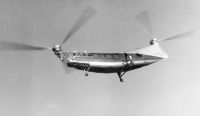
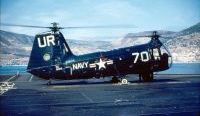
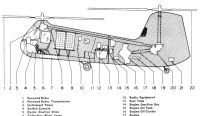


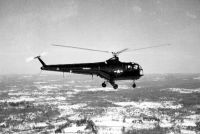


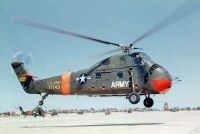
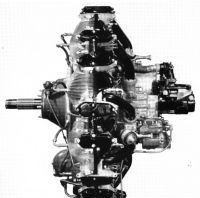
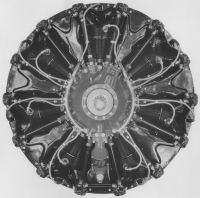
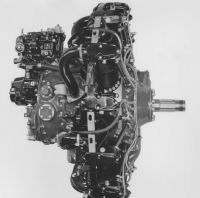
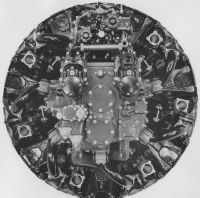
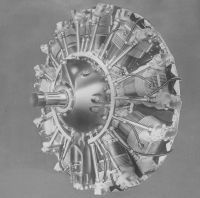
Wright Aero Helicopter Engines
by Carl Kuhns
8 November 2015
Introduction
Prior to the development of powerful turboshaft engines, helicopter manufacturers used existing fixed wing aircraft engines for power. Certain basic changes were necessary to make a fixed wing aircraft engine suitable for helicopter use. Because the helicopter engine was enclosed in the body of the helicopter, there was no slipstream or propeller blast to cool an air cooled engine. This required an engine-driven fan for cooling. A flywheel was been designed as part of the cooling fan. The flywheel also served as a starting load in lieu of the usual propeller. Another change from fixed wing Wright engines was the elimination of the nose case reduction gears. The task of reducing the engine rpm to the lift rotor of about 250 rpm was accomplished at the rotor gear box.
The peculiar operating conditions of helicopters required their engines to operate at a much higher sustained speed than those of fixed-wing aircraft. The cruise requirements of a helicopter called for a 70% or more power setting. A hydro-mechanical or automatic centrifugal clutch was necessary to allow the engine to be engaged or disengaged from the rotors.
Wright Aero Powered Helicopters
Wright engines were used in eight different helicopter models: one Kellett, four Piaseckis, and three Sikorskys.
W. Wallace Kellett’s company, The Kellett Autogiro Corporation built autogiros, and later switched to the design of helicopters.
Frank Piasecki (1919-2008) founded the P-V Engineering Forum in 1940, which became the Piasecki Helicopter Corporation in 1946. The Piasecki Helicopter Corporation was renamed The Vertol Corporation in 1956.
Igor Sikorsky (1889-1972) built his first practical helicopter in 1939.
The Wright engine designs used in helicopters were the R-975, R-1300, R-1820. During World War II, Continental produced the Wright R-975 Whirlwind under license. The R-975 engine powered training aircraft and armored vehicles such as the Sherman tank. After the war, Wright showed no interest in continuing to manufacture the R-975. Continental then began producing the R-975 with improvements that increased the horsepower to 550. These were all radial engines; the R-1820 and Continental R-975 had nine cylinders, and the R-1300 had seven.
| Helicopter Specifications | |||
|---|---|---|---|
| Make and Model | First Flight | Powerplant | Number Produced |
| Kellett | |||
| Kellett XR-10 (Army) | April 1947 | Two Continental R-975-15 | 2 |
| Piasecki | |||
| PV Engineering Forum PV-3 (Army XHRP-X) | March 1945 | One Continental R-975-34 | 2 |
| Piasecki PV-18 (Navy HUP-1) | March 1948 | One Continental R-975-34 | 339 |
| Piasecki PV-18 (Navy HUP-2, later UH-25 Retriever) | ? | One Continental R-975-42 | |
| Piasecki PV-18 (Navy HUP-3 Retriever, Army H-25A Army Mule) | ? | One Continental R-975-46 | |
| Piasecki/Vertol Model 44 (Army H-21) | April 1952 | One Wright R-1820-103 | 707 |
| Piasecki/Vertol Models 44A, 44B (Commercial) | ? | One Wright 977C9HD1, 977C9HD2, or 977C9HD3 | |
| Sikorsky | |||
| Sikorsky S-53 (Navy XHJS-1) | September 1947 | One Continental R-975-34 | 3 |
| Sikorsky S-55 (Army H-19, Coast Guard HO4S, Marine Corps HRS) | November 1949 | One Wright R-1300-3 | 1,758* |
| Sikorsky S-55 (Commercial) | ? | One Wright 990C7BA1 | |
| * Includes Some with Pratt & Whitney R-1340 Power | |||
| Sikorsky S-58 (Army H-34, Navy HUS-1 and HSS-1) | March 1954 | One Wright R-1820-84 | 2,260 |
| Sikorsky S-58 (Commercial) | ? | One Wright 989C9HE1 or 989C9HE2 | |
| Sikorsky S-58A, B, C (Commercial) | ? | One Wright 999C9HE1 or 999C9HE2 | |
| Engine Specifications | ||||||||||||
|---|---|---|---|---|---|---|---|---|---|---|---|---|
| Military Model |
WAD Model |
Disp (in3) |
Takeoff Rating (BHP @ RPM) |
Normal Rating (BHP @ RPM) |
Fuel Grade | Impeller Ratio |
Max MP (inHgA) |
Magneto Type | Weight (lb) |
Weight/BHP (lb/BHP) |
FAA Type Certificate |
Licensee(s) |
| Continental | ||||||||||||
| R-975-15 | 972 | 525 @ 2,300 | 500 @ 2,300 | 91/96 | 10.15:1 | 43.0 | High Tension | 700 | 1.333 | |||
| R-975-34 | 972 | 525 @ 2,300 | 500 @ 2,300 | 100/130 | 10.15:1 | 43.0 | High Tension | 705 | 1.343 | |||
| R-975-42 | 972 | 550 @ 2,400 | 525 @ 2,300 | 115/145 | 10.15:1 | 44.0 | High Tension | 730 | 1.327 | |||
| R-975-46 | 972 | 475 @ 2,350 | 450 @ 2,350 | 100/130 | 10.15:1 | 39.0 | High Tension | 730 | 1.537 | |||
| Wright Aeronautical Division of Curtiss-Wright Corporation | ||||||||||||
| R-1300-3 | 871C7BA1 | 1,301 | 800 @ 2,600 | 700 @ 2,400 | 91/96 | 7.21:1 | 44 | High Tension | 1,080 | 1.350 | Lycoming Kaiser-Frazer |
|
| 990C7BA1 | 1,301 | 800 @ 2,600 | 700 @ 2,400 | 91/96 | 7.21:1 | 43.5 | High Tension | 1,070 | 1.338 | E-289 | Lycoming Kaiser-Frazer |
|
| R-1820-84 | 1,823 | 1,525 @ 2,800 | 1,275 @ 2,500 | 115/145 | 7.21:1 | 56.5 | Low Tension | 1,405~1,427 | 0.927~0.936 | Lycoming | ||
| 989C9HE1 | 1,823 | 1,525 @ 2,800 | 1,275 @ 2,500 | 115/145 | 7.21:1 | 56.5 | Low Tension | 1,401 | 0.919 | E-259 | Lycoming | |
| 989C9HE2 | 1,823 | 1,525 @ 2,800 | 1,275 @ 2,500 | 115/145 | 7.21:1 | 56.5 | Low Tension | 1,419 | 0.930 | E-259 | Lycoming | |
| R-1820-103 | 863C9HD1 | 1,823 | 1,425 @ 2,700 | 1,275 @ 2,500 | 100/130 | 7.21:1 10.14:1 |
51.5 50.5 |
High Tension | 1,350 | 0.947 | Lycoming | |
| 977C9HD1 | 1,823 | 1,425 @ 2,700 | 1,275 @ 2,500 | 100/130 | 7.21:1 10.14:1 |
52.5 43.0 |
High Tension | 1,349 | 0.947 | E-243 | Lycoming | |
| 977C9HD2 | 1,823 | 1,425 @ 2,700 | 1,275 @ 2,500 | 100/130 | 7.21:1 8.69:1 |
52.5 48.5 |
High Tension | 1,349 | 0.947 | E-243 | Lycoming | |
| 977C9HD3 | 1,823 | 1,425 @ 2,700 | 1,275 @ 2,500 | 100/130 | 7.21:1 | 52.5 | High Tension | 1,349 | 0.947 | E-243 | Lycoming | |
Acknowledgments
Kim McCutcheon for providing source material and encouragement.
My wife, Carol, who typed the final draft from my handwritten notes.
Sources
1. “Adapting Cyclones for Copter Use” Aviation Week, May 14, 1951
2. Wright Aircraft Engines, Military Helicopter Installation, Cyclone 7 and Cyclone 9 Models. Curtiss Wright Corporation, Wood-Ridge ,New Jersey, March 1959.
3. Pilot’s Handbook Navy Models HUP-1 and HUP-2 Helicopters. 1 May 1952.
4. H-34 Pocket Guide. Sikorsky Service School Publication, 1 June 1962.
5. Flight Manual H-34 G Helicopters. The Chief of the Bureau of Naval Weapons, 1 July 1963.
6. https://en.wikipedia.org/wiki/Piasecki_H-21
7. https://en.wikipedia.org/wiki/Piasecki_HUP_Retriever
8. www.sikorskyarchives.com/index.php
9. www.piasecki.com/index.php
10. https://en.wikipedia.org/wiki/Kellett_XR-10
11. engine history.org/reference.shtml#CW
12. F.A.A. Type Certificate Data Sheets E-243, E-259, E-289.